Assessment of Aesthetic Preferences in Relation to Vegetation-Created Enclosure in Chinese Urban Parks: A Case Study of Shenzhen Litchi Park
Abstract
1. Introduction
1.1. Enclosure in the Context of Urban Parks
1.2. Characterization of Enclosure
1.3. Cognition and Preference
1.4. Landscape Visualization
2. Materials and Methods
2.1. Research Questions and Hypothesis
2.2. Research Design
- Four viewpoints (A, B, C, and D) in Shenzhen Litchi Park with fields of view and different levels of enclosure were chosen (Figure 1);
- Using species which already exist in the park, four configurations of visual and physical enclosure (scenes) were designed;
- Autodesk Rhinoceros3D and Xfrog 3-D plant models were used to create middle-ground views from eye-level perspectives with four different levels of enclosure;
- Adobe Photoshop was used to match the corresponding photographs for the background and foreground details and to ensure the validity of the visualizations;
- The online questionnaire was piloted with the preference study using 48 images to test the aesthetic preferences in terms of enclosure, complexity, legibility, and coherence;
- Participants were recruited through WeChat and Weibo, two social networking platforms in China;
- The online questionnaire was conducted with 303 participants (n = 303);
- The statistical analysis of the survey data was performed in IBM SPSS 22.
2.3. Case Study—Litchi Park, Shenzhen, China
2.4. Selection of Viewpoints According to Scale, Distance, and Field of View
2.5. Approaches to Landscape Visualization
2.6. Survey Design
3. Results
3.1. Respondents
3.2. Evaluation of Enclosure and Coherence, Complexity, and Legibility
3.3. Physical Enclosure and Coherence, Complexity, and Legibility
3.4. Visual Enclosure and Aesthetic Preference Variables
3.5. Summary
- Complexity/legibility and enclosure are significantly correlated. The results for all 16 scenes show that if the visual and/or physical setting is/are enclosed, the participants’ legibility ratings are lower than in the open scenes, supporting the second and third hypotheses.
- Not all correlations between coherence and enclosure are significant, i.e., the ANOVA test does not fully support the first hypothesis. In visually open situations, there are no obvious differences in the participants’ ratings of coherence if the scene is changed to a physically enclosed one. In visually enclosed situations, physically open scenes show a higher coherence than physically enclosed scenes.
- Physical enclosure and complexity are significantly correlated, supporting hypothesis (3). Complexity is rated lower for physically enclosed scenes than physically open scenes. In physically open scenes, there are no clear correlations between visual enclosure and complexity. In physically enclosed scenes, the participants rate complexity higher for visually open scenes than for visually enclosed scenes.
4. Discussion
4.1. Recommendations
4.2. Methodological Limitations
5. Conclusions
Supplementary Materials
Author Contributions
Funding
Acknowledgments
Conflicts of Interest
References
- Stamps, A.E.; Smith, S. Environmental enclosure in urban settings. Environ. Behav. 2002, 34, 781–794. [Google Scholar] [CrossRef]
- Van den Berg, A.E.; Jorgensen, A.; Wilson, E.R. Evaluating restoration in urban green spaces: Does setting type make a difference? Landscape Urban Plan. 2014, 127, 173–181. [Google Scholar] [CrossRef]
- Thwaites, K.; Helleur, E.; Simkins, I.M. Restorative urban open space: Exploring the spatial configuration of human emotional fulfilment in urban open space. Landsc. Res. 2005, 30, 525–547. [Google Scholar] [CrossRef]
- Xue, F.; Gou, Z.; Lau, S.S. Green open space in high-dense Asian cities: Site configurations, microclimates and users’ perceptions. Sustain. Cities Soc. 2017, 34, 114–125. [Google Scholar] [CrossRef]
- Wang, Y.X. Primary Exploration of Landscape Spatial Design. Ph.D. Thesis, Huazhong Agricultural University, Wuhan, China, 2000. [Google Scholar]
- Zhao, A.H.; Li, D.M.; Hu, H.Y.; Fan, J.X. Studies on Constructing Garden Space with Landscape Plants. J. Northwest For. Univ. 2004, 19, 136–138. [Google Scholar]
- Li, X. The Arrangement Model of Landscape Plants in Guangzhou City Parks and Build of Information System. Master’s Thesis, Northeast Forestry University, Harbin, China, 2009. [Google Scholar]
- Tao, J.; Liu, Y. Analyses of Psychological Feeling of Colour. J. Southwest Univ. Natl. 2002, 23, 76–77. [Google Scholar]
- Zang, D.K. Chosen and Configuration of Colourful Tree Species; Chinese Forestry Press: Beijing, China, 2003. (In Chinese) [Google Scholar]
- Yao, Y.; Zhu, X.; Xu, Y.; Yang, H.; Wu, X.; Li, Y.; Zhang, Y. Assessing the Visual Quality of Green Landscaping in Rural Residential Areas: The Case of Changzhou, China. Environ. Monit. Assess. 2012, 184, 951. [Google Scholar] [CrossRef]
- Zhang, H.; Chen, B.; Sun, Z.; Bao, Z. Landscape perception and recreation needs in urban green space in Fuyang, Hangzhou, China. Urban For. Urban Green. 2013, 12, 44–52. [Google Scholar] [CrossRef]
- Wang, X.; Rodiek, S.; Wu, C.; Chen, Y.; Li, Y. Stress Recovery and Restorative Effects of Viewing Different Urban Park Scenes in Shanghai, China. Urban For. Urban Green. 2016, 15, 112–122. [Google Scholar] [CrossRef]
- Greenbie, B. Spaces: Dimension of the Human Landscape; Yale University Press: New Haven, CT, USA, 1981; ISBN 0300025491. [Google Scholar]
- Kaplan, R.; Kaplan, S. The Experience of Nature: A Psychological Perspective; Cambridge University Press: New York, NY, USA, 1989; ISBN 0521341396. [Google Scholar]
- Kaplan, R.; Kaplan, S.; Brown, T. Environmental Preference. Environ. Behav. 1989, 5, 509–530. [Google Scholar] [CrossRef]
- Herzog, T.R. A Cognitive Analysis of Preference for Urban Spaces. J. Environ. Psychol. 1992, 12, 237–248. [Google Scholar] [CrossRef]
- Wall, E.; Waterman, T. Basics Landscape Architecture 01: Urban Design (Vol. 1); AVA Publishing: Worthing, UK, 2010; ISBN 978-2940411122. [Google Scholar]
- Robinson, N. The Planting Design Handbook, 2nd ed.; Ashgate Publishing Limited: Farnham, UK, 2004; ISBN 978-0754677161. [Google Scholar]
- Mahmoud, A.H.; Omar, R.H. Planting design for urban parks: Space syntax as a landscape design assessment tool. Front. Archit. Res. 2015, 4, 35–45. [Google Scholar] [CrossRef]
- Chen, B.; Adimo, O.A.; Bao, Z. Assessment of Aesthetic Quality and Multiple Functions of Urban Green Space from the Users’ Perspective: The Case of Hangzhou Flower Garden, China. Landsc. Urban Plan. 2009, 93, 76–82. [Google Scholar] [CrossRef]
- Appleton, J. The Experience of Landscape; Wiley: Chichester, UK, 1996; ISBN 978-0471962359. [Google Scholar]
- Bourassa, S.C. The Aesthetics of Landscape; Belhaven Press: London, UK, 1991; ISBN 978-1852930714. [Google Scholar]
- Carlson, A. Aesthetic Preferences for Sustainable Landscapes: Seeing and Knowing. Forests and Landscapes-linking Ecology, Sustainability and Aesthetics. IUFRO Res. Ser. 2001, 31–41. [Google Scholar] [CrossRef]
- Fry, G.; Tveit, M.S.; Ode, Å.; Velarde, M.D. The ecology of visual landscapes: Exploring the conceptual common ground of visual and ecological landscape indicators. Ecol. Indic. 2009, 9, 933–947. [Google Scholar] [CrossRef]
- Yu, K. Landscape Preference: BIB-LCJ Procedure and Comparison of Landscape Preference among Different Groups. J. Beijing For. Univ. 1988, 10, 1–11. [Google Scholar]
- Zhou, C.L.; Zhang, Q.X.; Sun, Y.K. Scenic Beauty Estimation of Residential Quarter Green Area. Chin. Landsc. Archit. 2006, 4, 014. [Google Scholar]
- Zheng, Y. Characteristics of Vegetation Community and Landscape Evaluation in the Urban Parks in Harbin. Master’s Thesis, Northeast Forestry University, Harbin, China, 2007. [Google Scholar]
- Stamps, A.E. Mystery, Complexity, Legibility and Coherence: A Meta-analysis. J. Environ. Psychol. 2004, 24, 1–16. [Google Scholar] [CrossRef]
- Tveit, M.; Ode, Å.; Fry, G. Key concepts in a framework for analysing visual landscape character. Landsc. Res. 2006, 31, 229–255. [Google Scholar] [CrossRef]
- Sevenant, M.; Antrop, M. Cognitive Attributes and Aesthetic Preferences in Assessment and Differentiation of Landscapes. J. Environ. Manag. 2009, 90, 2889–2899. [Google Scholar] [CrossRef]
- Daniel, T.C.; Boster, R. Measuring Landscape Esthetics: The Scenic Beauty Estimation Method; USDA Forest Service Research Paper RM-167. Available online: https://www.fs.usda.gov/treesearch/pubs/20911 (accessed on 10 October 2018).
- Daniel, T.C. Whither scenic beauty? Visual landscape quality assessment in the 21st century. Landsc. Urban Plan. 2001, 54, 267–281. [Google Scholar] [CrossRef]
- Lange, E. The limits of realism: Perceptions of virtual landscapes. Landsc. Urban Plan. 2001, 54, 163–182. [Google Scholar] [CrossRef]
- Bishop, I.D.; Ye, W.-S.; Karadaglis, C. Experiential approaches to perception response in virtual worlds. Landsc. Urban Plan. 2001, 54, 117–125. [Google Scholar] [CrossRef]
- Bishop, I.D.; Rohrmann, B. Subjective responses to simulated and real environments: A comparison. Landsc. Urban Plan. 2003, 65, 261–277. [Google Scholar] [CrossRef]
- Lovett, A.; Appleton, K.; Warren-Kretzschmar, B.; Von Haaren, C. Using 3D visualization methods in landscape planning: An evaluation of options and practical issues. Landsc. Urban Plan. 2015, 142, 85–94. [Google Scholar] [CrossRef]
- Kuper, R. Evaluations of landscape preference, complexity, and coherence for designed digital landscape models. Landsc. Urban Plan. 2017, 157, 407–421. [Google Scholar] [CrossRef]
- Ervin, S.M.; Hasbrouck, H.H. Landscape Modeling: Digital Techniques for Landscape Visualization; McGraw-Hill: New York, NY, USA, 2001; ISBN 978-0071357456. [Google Scholar]
- Gill, L.R. A 3D Landscape Information Model: Using Real-time 3D Graphics for Site-based Landscape Design. Ph.D. Thesis, The University of Sheffield, Sheffield, UK, 2013. Available online: http://etheses.whiterose.ac.uk/id/eprint/4879 (accessed on 15 March 2018).
- Shenzhen Statistics Bureau; NBS Survey Office. Shenzhen Statistical Yearbook 2015 (Report No. 25); China Statistics Press: Beijing, China, 2015.
- Ren, Y.Y.; Shen, S.Y. Analysis on the Landscape Planning of Litchi Park in Shenzhen. North. Hortic. 2012, 8, 040. [Google Scholar]
- Panero, J.; Zelnik, M. Human Dimension & Interior Space; Whitney Library of Design: New York, NY, USA, 1979; ISBN 978-0823072712. [Google Scholar]
- Roth, M. Validating the Use of Internet Survey Techniques in Visual Landscape Assessment—An Empirical Study from Germany. Landsc. Urban Plan. 2006, 78, 179–192. [Google Scholar] [CrossRef]
- Bishop, I.D. Testing Perceived Landscape Colour Difference Using the Internet. Landsc. Urban Plan. 1997, 37, 187–196. [Google Scholar] [CrossRef]
- Wherrett, J.R. Issues in Using the Internet as a Medium for Landscape Preference Research. Landsc. Urban Plan. 1999, 45, 209–217. [Google Scholar] [CrossRef]
- MacDonald, A.M. Windfarm Visualization: Perspective or Perception? Whittles Publishing: Scotland, UK, 2012; ISBN 978-1849950534. [Google Scholar]
- Nicholas, D.; Rowlands, I. Social media use in the research workflow. Inf. Serv. Use 2011, 31, 61–83. [Google Scholar] [CrossRef]
- Eyrich, N.; Padman, M.L.; Sweetser, K.D. PR practitioners’ use of social media tools and communication technology. Public Relat. Rev. 2008, 34, 412–414. [Google Scholar] [CrossRef]
- Lyons, E. Demographic Correlates of Landscape Preference. Environ. Behav. 1983, 15, 487–511. [Google Scholar] [CrossRef]
- Modica, G.; Zoccali, P.; Di Fazio, S. The e-participation in tranquility areas identification as a key factor for sustainable landscape planning. In Proceedings of the International Conference on Computational Science and Its Applications, Ho Chi Minh City, Vietnam, 24–27 June 2013; pp. 550–565. [Google Scholar] [CrossRef]
- Sklenicka, P.; Molnarova, K. Visual perception of habitats adopted for post-mining landscape rehabilitation. Environ. Manag. 2010, 46, 424–435. [Google Scholar] [CrossRef]
- Kaplan, S. Perception and Landscape: Conceptions and Misconceptions. Proceedings of Our National Landscape: A Conference on Applied Techniques for Analysis and Management of the Visual Resource, 1979. Available online: https://www.fs.usda.gov/treesearch/pubs/27585 (accessed on 19th Oct 2018).
- Rogge, E.; Nevens, F.; Gulinck, H. Perception of rural landscapes in Flanders: Looking beyond aesthetics. Landsc. Urban Plan. 2007, 82, 159–174. [Google Scholar] [CrossRef]
- Gobster, P.H.; Nassauer, J.I.; Daniel, T.C.; Fry, G. The Shared Landscape: What does Aesthetics have to do with Ecology? Landscape Ecology 2007, 22, 959–972. [Google Scholar] [CrossRef]
- Echelberger, H.E. The Semantic Differential in Landscape Research. In Proc. Our National Landscape: A Conference on Applied Technique for Analysis and Management of the Visual Resource, USDA Forest Service General Tech., 1979. Available online: http://www.treesearch.fs.fed.us/pubs/27623 (accessed on 18th Sept 2018).
- Wherrett, J.R. Creating Landscape Preference Models using Internet Survey Techniques. Landsc. Res. 2000, 25, 79–96. [Google Scholar] [CrossRef]
- Nyhus, E.; Curran, T. Semantic and Perceptual Effects on Recognition Memory: Evidence from ERP. Brain Res. 2009, 1283, 102–114. [Google Scholar] [CrossRef]
- Field, A. Discovering Statistics Using SPSS: Book Plus Code for E version of Text; SAGE Publications Ltd.: New York, NY, USA, 2009; ISBN 978-1849204088. [Google Scholar]
- Lynch, K. The Image of the City; MIT Press: London, UK, 1960; ISBN 9780262620017. [Google Scholar]
- Shi, S.; Gou, Z.; Chen, L.H.C. How does Enclosure Influence Environmental Preferences? A Cognitive Study on Urban Public Open Spaces in Hong Kong. Sustain. Cities Society 2014, 13, 148–156. [Google Scholar] [CrossRef]
- Li, W.; Ouyang, Z.; Meng, X.; Wang, X. Plant Species Composition in Relation to Green Cover Configuration and Function of Urban Parks in Beijing, China. Ecol. Res. 2006, 21, 221–237. [Google Scholar] [CrossRef]
- Li, W. Study on Designing of Landscape Plant Space: A Case of the West Lake Green Space in Hangzhou. Master’s Thesis, Zhejiang University, Hangzhou, China, 2007. [Google Scholar]
- Lü, H. Research on the Relationship between Recreation Activity and Space of the City Park. Ph.D. Thesis, Shandong Agricultural University, Jinan, China, 2013. [Google Scholar]
- Herzog, T.R.; Miller, E.J. The Role of Mystery in Perceived Danger and Environmental Preference. Environ. Behav. 1998, 30, 429–444. [Google Scholar] [CrossRef]
- Li, D.; Liu, G.; Hao, F. Study on the Use of Function of Urban Parks: Two Cases of Shijiazhuang Chang’ an Park and Shuishang Park. Chin. Agric. Sci. Bull. 2010, 26, 210–2014. [Google Scholar]
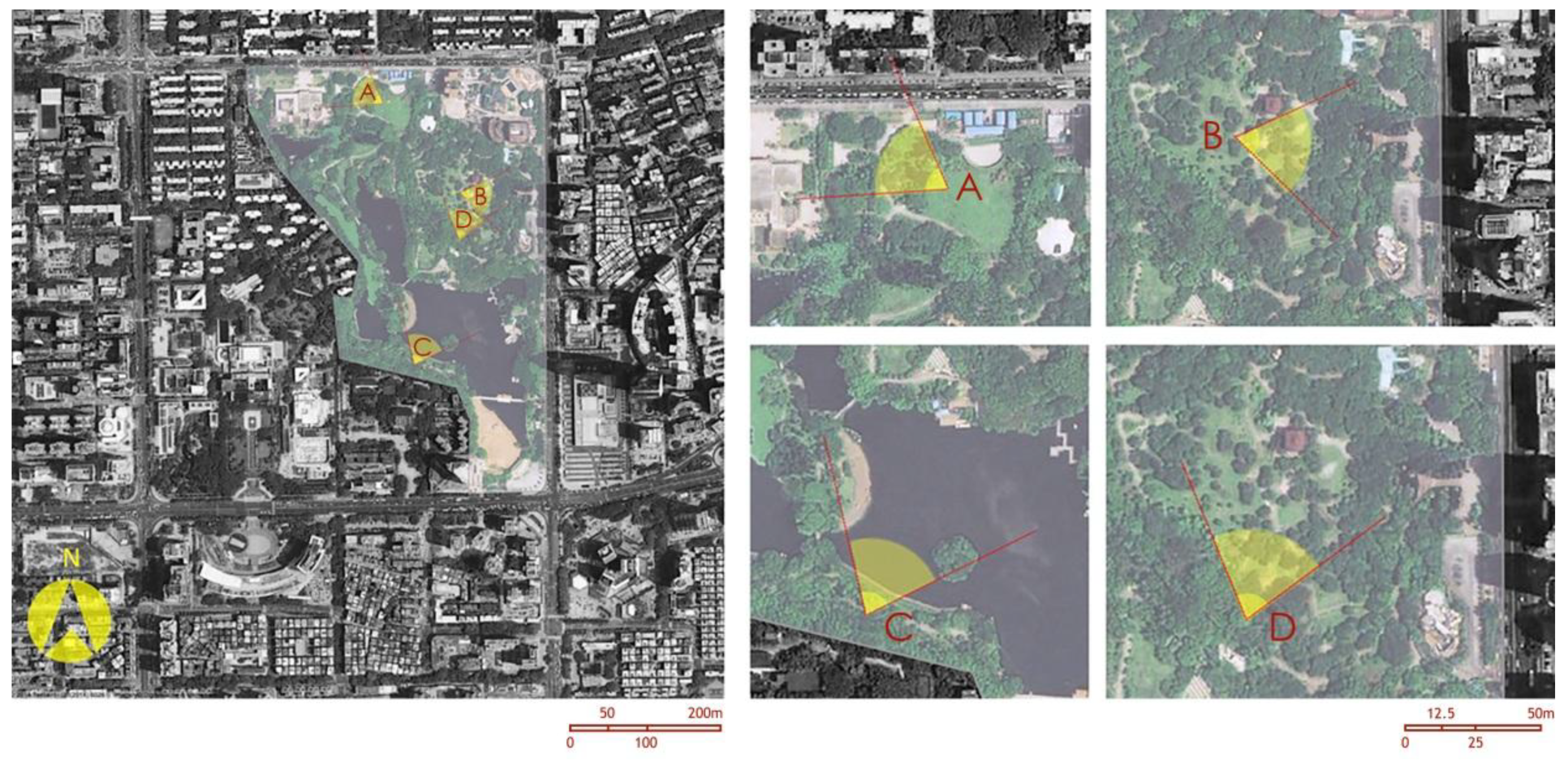
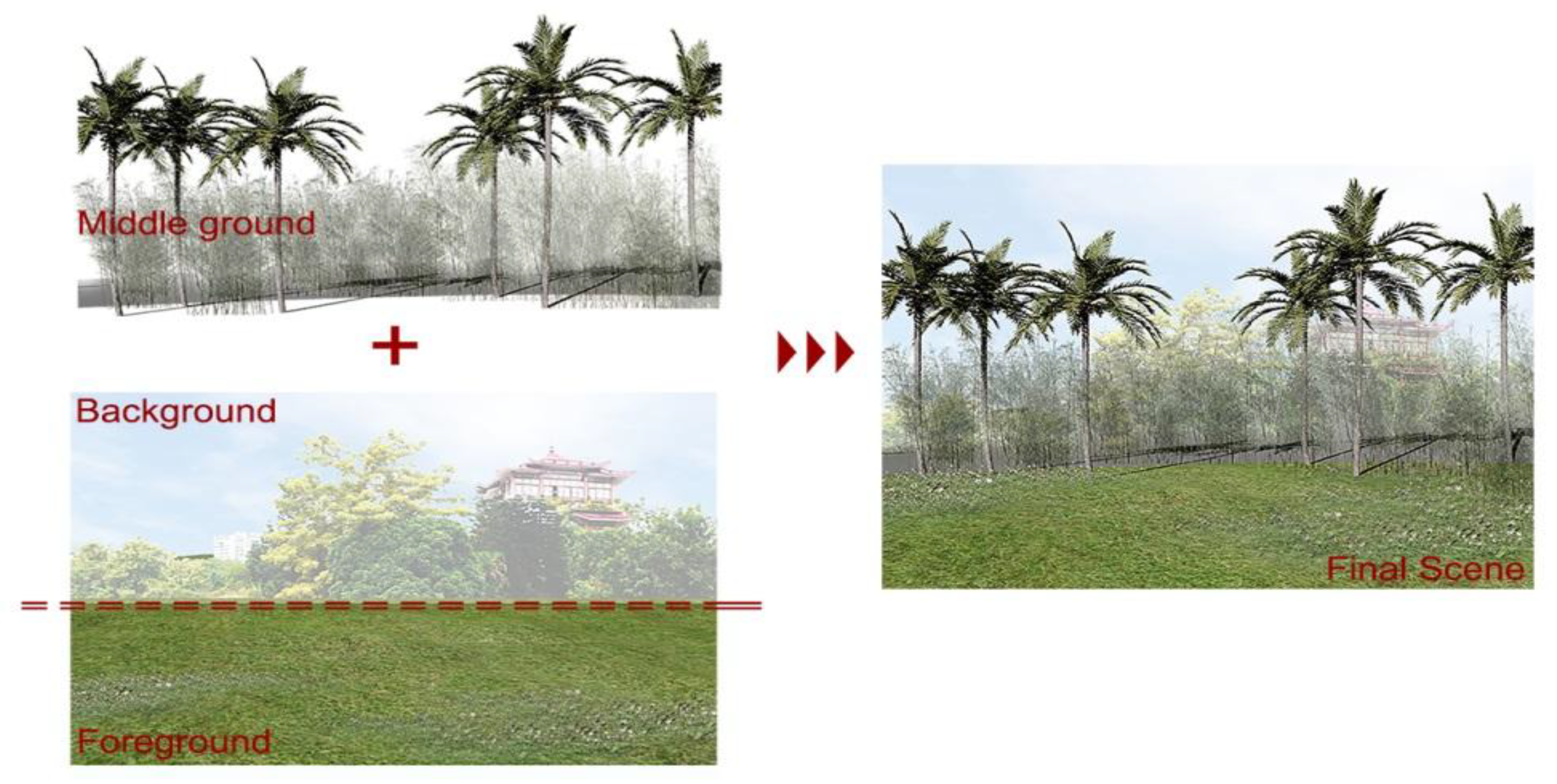
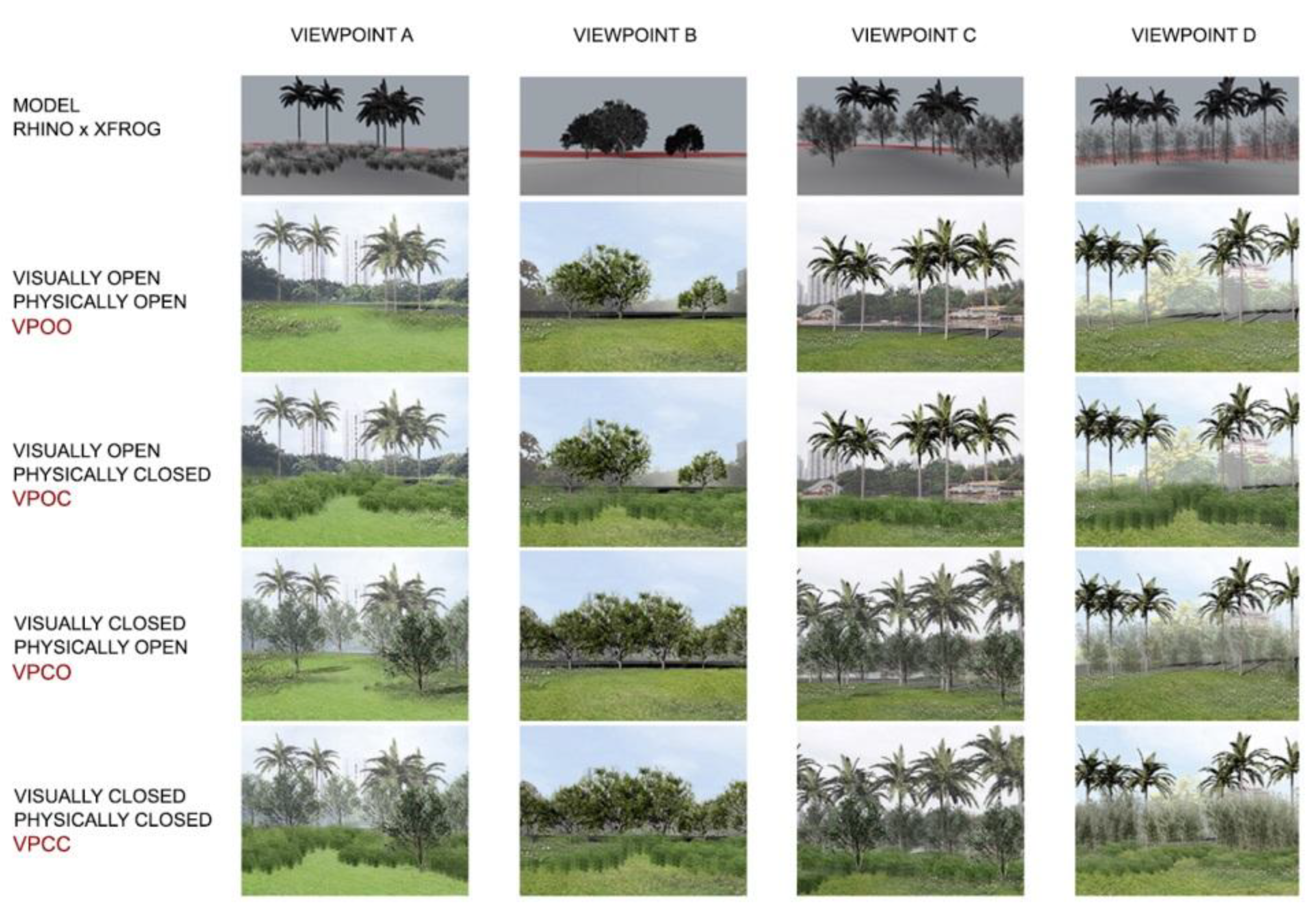
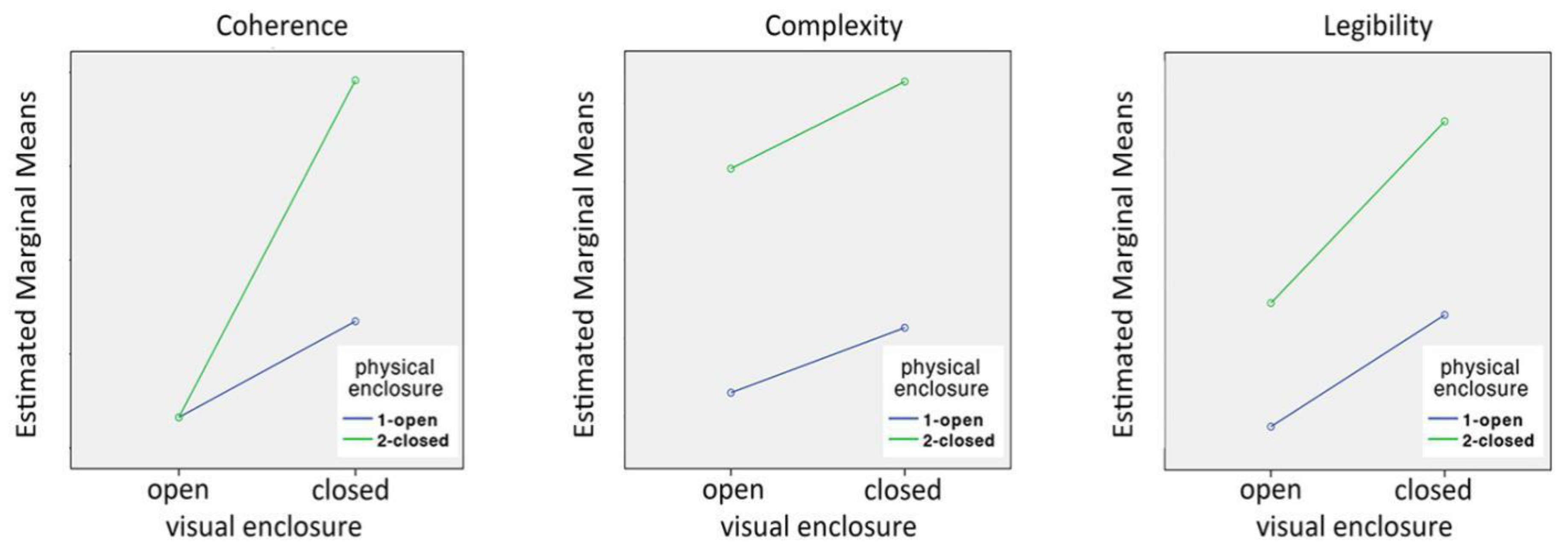
| Permeability of Enclosure | Description | Typology |
|---|---|---|
| Visually open, physically open | Planting at knee height or below allows complete visibility and movement, or having branches above eye level allows physical movement. | 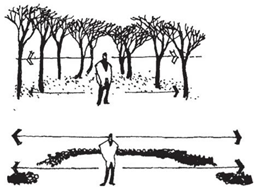 |
| Visually enclosed, physically enclosed | Trees forming canopies block visibility, or there are big shrub canopies at eye level, with knee-height shrubs or ground cover to stop movement. | 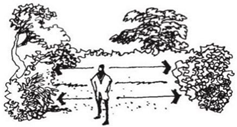 |
| Visually open, physically enclosed | Full visibility is provided by planting below eye level; shrubs are planted at knee height to hinder movement. |  |
| Visually enclosed, physically open | Trees forming canopies block visibility, but the trunks still allow movement. |  |
| Viewpoint | Vegetation Species |
|---|---|
| Viewpoint A and C | Roystonea regia (Kunth) O.F.Cook, Lagerstroemia speciosa (L.) Pers., Ficus microcarpa L. f. cv. Golden Leaves, and Wedelia chinensis (Osbeck) Merr. |
| Viewpoint B | Litchi chinensis Sonn., Ficus microcarpa L. f. cv. Golden Leaves, and Wedelia chinensis (Osbeck) Merr. |
| Viewpoint D | Roystonea regia (Kunth) O.F.Cook, Rhapis gracilis Burret, Ficus microcarpa L. f. cv. Golden Leaves, and Wedelia chinensis (Osbeck) Merr. |
| Factors | Coherence | Complexity | Legibility |
|---|---|---|---|
| Visual enclosure | F = 46.178, p < 0.001 | F = 51.271, p < 0.001 | F = 245.558, p < 0.001 |
| Physical enclosure | F = 14.285, p < 0.001 | F = 490.543, p < 0.001 | F = 286.573, p < 0.001 |
| Visual enclosure and Physical enclosure | F = 14.285, p < 0.001 | F = 1.081, p = 0.299, NS | F = 13.961, p < 0.001 |
| Pair No. | Aesthetic Preference for Scenes | Sig. | Mean |
|---|---|---|---|
| Pair 1 | CoVPOO_A1 vs. CoVPOC_A2 | 0.000 *** | 2.94 vs. 3.15 |
| Pair 2 | CoVPCO_A3 vs. CoVPCC_A4 | 0.000 *** | 2.84 vs. 3.14 |
| Pair 3 | CVPOO_A1 vs. CVPOC_A2 | 0.000 *** | 2.96 vs. 3.44 |
| Pair 4 | CVPCO_A3 vs. CVPCC_A4 | 0.000 *** | 3.01 vs. 3.53 |
| Pair 5 | LVPOO_A1 vs. LVPOC_A2 | 0.000 *** | 2.97 vs. 3.30 |
| Pair 6 | LVPCO_A3 vs. LVPCC_A4 | 0.000 *** | 2.99 vs. 3.53 |
| Pair No. | Aesthetic Preference for Scenes | Mean | Sig. | Pair No. | Aesthetic Preference for Scenes | Mean | Sig. |
|---|---|---|---|---|---|---|---|
| Pair 1 | LVPCO_B1 LVPCC_B4 | 2.69 3.41 | 0.000 *** | Pair 7 | CVPCO_B1 CVPCC_B4 | 2.48 3.47 | 0.000 *** |
| Pair 2 | LVPOO_B3 LVPOC_B2 | 2.53 3.20 | 0.000 *** | Pair 8 | CVPOO_B3 CVPOC_B2 | 2.5 63.42 | 0.000 *** |
| Pair 3 | LVPOO_C2 LVPOC_C1 | 1.99 2.24 | 0.000 *** | Pair 9 | CVPOO_C2 CVPOC_C1 | 2.2 62.89 | 0.000 *** |
| Pair 4 | LVPCO_C4 LVPCC_C3 | 2.97 3.80 | 0.000 *** | Pair 10 | CVPCO_C4 CVPCC_C3 | 2.85 3.76 | 0.000 *** |
| Pair 5 | LVPCO_D3 LVPCC_D1 | 2.98 3.74 | 0.000 *** | Pair 11 | CVPCO_D3 CVPCC_D1 | 2.83 3.56 | 0.000 *** |
| Pair 6 | LVPOO_D4 LVPOC_D2 | 2.52 3.06 | 0.000 *** | Pair 12 | CVPOO_D4 CVPOC_D2 | 2.61 3.44 | 0.000 *** |
| Pair No. | Aesthetic Preference for Scenes | Mean | Sig. | Pair No. | Aesthetic Preference for Scenes | Mean | Sig. |
|---|---|---|---|---|---|---|---|
| Pair 1 | CoVPOO_A1 | 2.94 | 0.090 | Pair 7 | CoVPOC_B2 | 3.06 | 1.000 |
| CoVPCO_A3 | 2.84 | CoVPCC_B4 | 3.06 | ||||
| Pair 2 | CoVPOC_A2 | 3.13 | 0.474 | Pair 8 | CoVPOO_B3 | 3.05 | 0.000 *** |
| CoVPCC_A4 | 3.17 | CoVPCO_B1 | 2.83 | ||||
| Pair 3 | CVPOO_A1 | 2.97 | 0.404 | Pair 9 | CoVPOC_C1 | 2.29 | 0.000 *** |
| CVPCO_A3 | 3.02 | CoVPCC_C3 | 3.40 | ||||
| Pair 4 | CVPOC_A2 | 3.47 | 0.160 | Pair 10 | CoVPOO_C2 | 2.43 | 0.000 *** |
| CVPCC_A4 | 3.55 | CoVPCO_C4 | 2.96 | ||||
| Pair 5 | LVPOO_A1 | 3.00 | 0.946 | Pair 11 | CoVPOC_D2 | 2.84 | 0.000 *** |
| LVPCO_A3 | 3.01 | CoVPCC_D1 | 3.19 | ||||
| Pair 6 | LVPOC_A2 | 3.33 | 0.001*** | Pair 12 | CoVPOO_D4 | 2.91 | 0.008 *** |
| LVPCC_A4 | 3.52 | CoVPCO_D3 | 3.09 |
| Pair No. | Aesthetic Preference for Scenes | Mean | Sig. | Pair No. | Aesthetic Preference for Scenes | Mean | Sig. |
|---|---|---|---|---|---|---|---|
| Pair 13 | CVPOO_B3 | 2.56 | 0.194 | Pair 19 | LVPOO_B3 | 2.53 | 0.000 *** |
| CVPCO_B1 | 2.49 | LVPOC_B2 | 3.20 | ||||
| Pair 14 | CVPOC_B2 | 3.41 | 0.301 | Pair 20 | LVPCO_B1 | 2.69 | 0.000 *** |
| CVPCC_B4 | 3.47 | LVPCC_B4 | 3.41 | ||||
| Pair 15 | CVPOO_C2 | 2.24 | 0.000 *** | Pair 21 | LVPOO_C2 | 1.96 | 0.000 *** |
| CVPCO_C4 | 2.85 | LVPCO_C4 | 2.97 | ||||
| Pair 16 | CVPOC_C1 | 2.89 | 0.000 *** | Pair 22 | LVPOC_C1 | 2.25 | 0.000 *** |
| CVPCC_C3 | 3.76 | LVPCC_C3 | 3.80 | ||||
| Pair 17 | CVPOO_D4 | 2.61 | 0.001 *** | Pair 23 | LVPOO_D4 | 2.52 | 0.000 *** |
| CVPCO_D3 | 2.82 | LVPCO_D3 | 2.98 | ||||
| Pair 18 | CVPOC_D2 | 3.45 | 0.063 | Pair 24 | LVPOC_D2 | 3.07 | 0.000 *** |
| CVPCC_D1 | 3.57 | LVPCC_D1 | 3.73 |
© 2019 by the authors. Licensee MDPI, Basel, Switzerland. This article is an open access article distributed under the terms and conditions of the Creative Commons Attribution (CC BY) license (http://creativecommons.org/licenses/by/4.0/).
Share and Cite
Liu, M.; Schroth, O. Assessment of Aesthetic Preferences in Relation to Vegetation-Created Enclosure in Chinese Urban Parks: A Case Study of Shenzhen Litchi Park. Sustainability 2019, 11, 1809. https://doi.org/10.3390/su11061809
Liu M, Schroth O. Assessment of Aesthetic Preferences in Relation to Vegetation-Created Enclosure in Chinese Urban Parks: A Case Study of Shenzhen Litchi Park. Sustainability. 2019; 11(6):1809. https://doi.org/10.3390/su11061809
Chicago/Turabian StyleLiu, Mei, and Olaf Schroth. 2019. "Assessment of Aesthetic Preferences in Relation to Vegetation-Created Enclosure in Chinese Urban Parks: A Case Study of Shenzhen Litchi Park" Sustainability 11, no. 6: 1809. https://doi.org/10.3390/su11061809
APA StyleLiu, M., & Schroth, O. (2019). Assessment of Aesthetic Preferences in Relation to Vegetation-Created Enclosure in Chinese Urban Parks: A Case Study of Shenzhen Litchi Park. Sustainability, 11(6), 1809. https://doi.org/10.3390/su11061809






